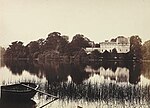Bardowie railway station
Former North British Railway stationsPages with no open date in Infobox stationRailway stations closed in 1931Railway stations in Great Britain opened in 1905Use British English from August 2019

Bardowie railway station was opened in 1905 on the Kelvin Valley Railway, later than most of the other stations which had opened with the line itself in 1879. It served the hamlet of Bardowie and the coal mining area, farms, etc. in East Dunbartonshire until 1931 for passengers and to freight on 31 July 1961.
Excerpt from the Wikipedia article Bardowie railway station (License: CC BY-SA 3.0, Authors, Images).Bardowie railway station
Station Road,
Geographical coordinates (GPS) Address External links Nearby Places Show on map
Geographical coordinates (GPS)
| Latitude | Longitude |
|---|---|
| N 55.9294 ° | E -4.2632 ° |
Address
Bardowie
Station Road
G62 6EU
Scotland, United Kingdom
Open on Google Maps








